HARRIS TR-0141-E XG-25P UHF Portable Land Mobile Radio User Manual Safety
HARRIS CORPORATION XG-25P UHF Portable Land Mobile Radio Safety
HARRIS >
Contents
- 1. User Manual Safety
- 2. User Manual
- 3. Users Manual
User Manual Safety
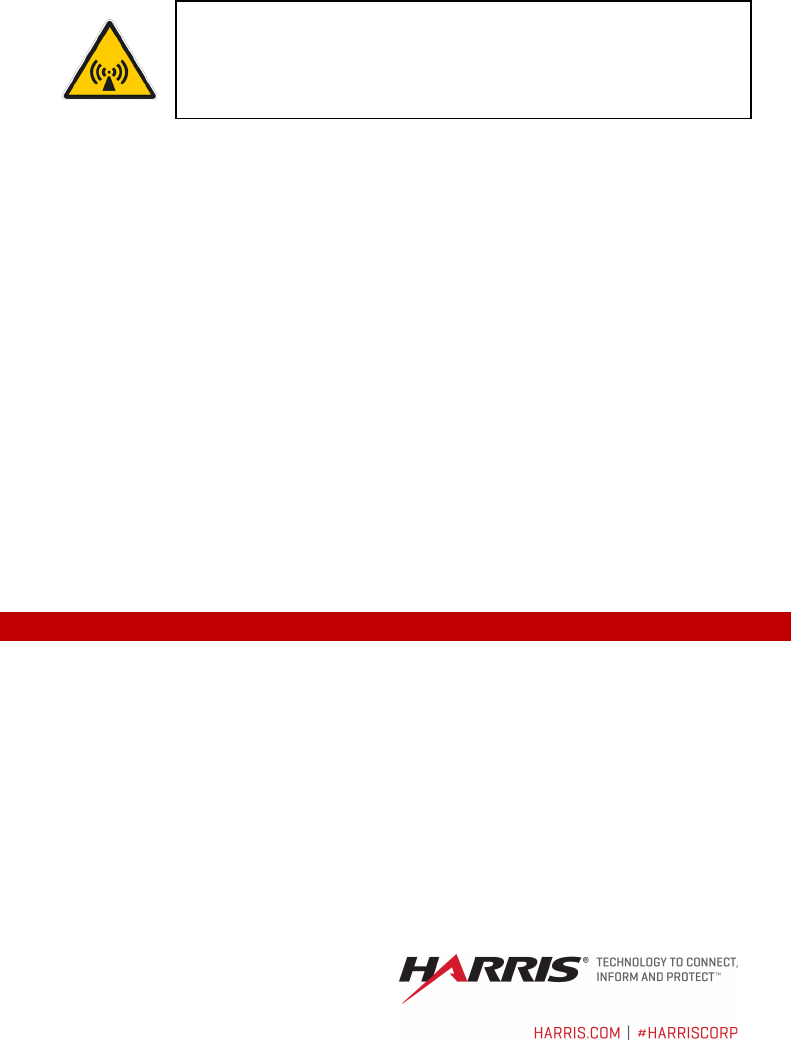
Product Safety Manual
14221-1500-2010
Rev. E, May 2016
This booklet contains important safety information regarding
specific absorption rate (SAR) and RF exposure limits included in
United States and international standards. Read the information
in this booklet before operating your radio.
XG-25P Series
Portable Radios

2 14221-1500-2010, Rev. E
REV
DATE
DESCRIPTION
-
Dec/11
Initial release
A
Oct/12
Added 700/800 MHz.
B
Sep/13
Added UHF-L and French translations. Updated warranty.
C
Jul/14
Added CE information. Add STORING LI-ION BATTERY
PACKS. Updated layout.
D
Aug/15
Added HAZLOC information.
E
May/16
Updated front and back cover.
ACKNOWLEDGEMENTS
The software contained in this device is copyrighted by Harris Corporation. Unpublished rights
are reserved under the copyright laws of the United States.
This device is made under license under one or more of the following US patents: 4,590,473;
4,636,791; 5,148,482; 5,185,796; 5,271,017; 5,377,229; 4,716,407; 4,972,460; 5,502,767;
5,146,497; 5,164,986; 5,185,795; 5,226,084; 5,247,579; 5,491,772; 5,517,511; 5,630,011;
5,649,050; 5,701,390; 5,715,365; 5,754,974; 5,826,222; 5,870,405; 6,161,089; and 6,199,037 B1.
DVSI claims certain rights, including patent rights under aforementioned U.S. patents, and under
other U.S. and foreign patents and patents pending. Any use of this software or technology
requires a separate written license from DVSI.
CREDITS
Harris, EDACS, and OpenSky are registered trademarks and ProVoice is a trademark of Harris
Corporation.
RBRC and 1-800-8-BATTERY are registered trademarks of Rechargeable Battery Recycling
Corporation.
AMBE is a registered trademark and IMBE, AMBE+, and AMBE+2 are trademarks of Digital
Voice Systems, Inc.
All other product and brand names are trademarks, registered trademarks, or service marks of
their respective holders.
NOTICE
The material contained herein is subject to U.S. export approval. No export or re-export is
permitted without written approval from the U.S. Government. Rated: EAR99; in accordance with
U.S. Dept. of Commerce regulations 15CFR774, Export Administration Regulations.
Information and descriptions contained herein are the property of Harris Corporation. Such
information and descriptions may not be copied or reproduced by any means, or disseminated or
distributed without the express prior written permission of Harris Corporation, PS&PC Division,
221 Jefferson Ridge Parkway, Lynchburg, VA 24501.
This product conforms to the European Union WEEE Directive 2012/19/EU. Do not
dispose of this product in a public landfill. Take it to a recycling center at the end of
its life.
Harris products comply with the Restriction of the Use of Certain Hazardous
Substances in Electrical and Electronic Equipment (RoHS) Directive.
The voice coding technology embodied in this product is protected by intellectual property rights
including patent rights, copyrights, and trade secrets of Digital Voice Systems, Inc. The user of
this technology is explicitly prohibited from attempting to decompile, reverse engineer, or
disassemble the Object Code, or in any other way convert the Object Code into human-readable
form.
Repairs to this equipment should be made only by an authorized service technician or facility
designated by the supplier. Any repairs, alterations, or substitution of recommended parts made
by the user to this equipment not approved by the manufacturer could void the user’s authority to
operate the equipment in addition to the manufacturer’s warranty.
This manual is published by Harris Corporation, without any warranty. Improvements and changes to this
manual necessitated by typographical errors, inaccuracies of current information, or improvements to programs
and/or equipment, may be made by Harris Corporation, at any time and without notice. Such changes will be
incorporated into new editions of this manual. No part of this manual may be reproduced or transmitted in any
form or by any means, electronic or mechanical, including photocopying and recording, for any purpose,
without the express written permission of Harris Corporation.
Copyright © 2011-2016 Harris Corporation.
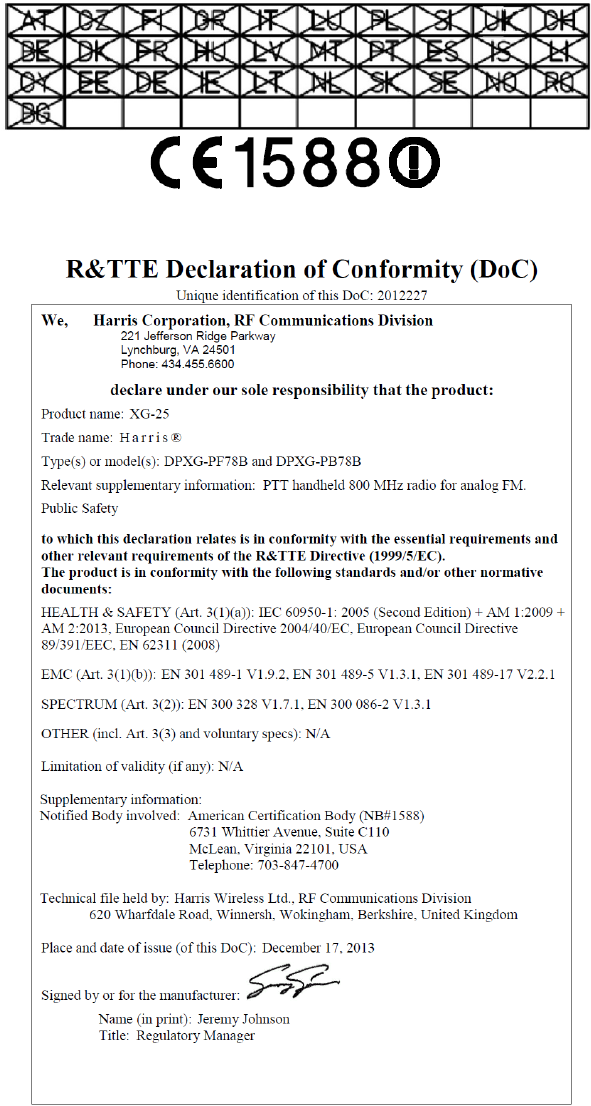
14221-1500-2010, Rev. E 3
This device is a RF transceiver intended for land mobile radio applications. The device
may have use restrictions, which require that the national authority be contacted for any
system licensing requirements, frequency use, allowable power level, etc.

4 14221-1500-2010, Rev. E
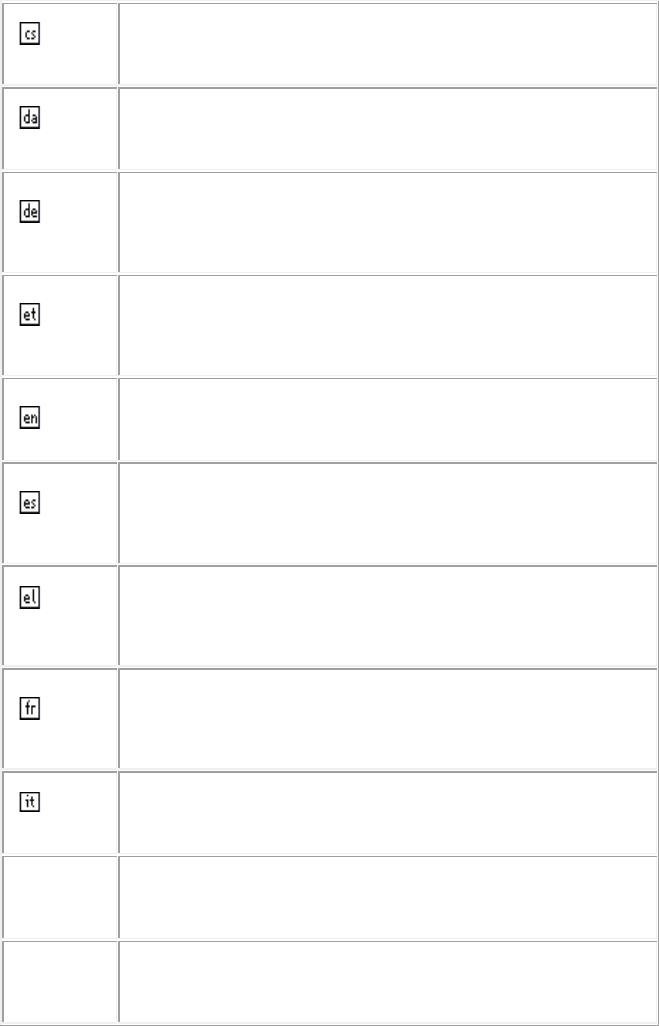
14221-1500-2010, Rev. E 5
Česky
[Czech]
Harris Corporation tímto prohlašuje, že tento XG 25P UHF-L (378-470
MHz), 7/800 (764-870MHz) je ve shodě se základními požadavky a
dalšími příslušnými ustanoveními směrnice 1999/5/ES.
Dansk
[Danish]
Undertegnede Harris Corporation erklærer herved, at følgende udstyr
XG 25P UHF-L (378-470 MHz), 7/800 (764-870MHz) overholder de
væsentlige krav og øvrige relevante krav i direktiv 1999/5/EF.
Deutsch
[German]
Hiermit erklärt Harris Corporation, dass sich das Gerät XG 25P UHF-L
(378-470 MHz), 7/800 (764-870MHz) in Übereinstimmung mit den
grundlegenden Anforderungen und den übrigen einschlägigen
Bestimmungen der Richtlinie 1999/5/EG befindet.
Eesti
[Estonian]
Käesolevaga kinnitab Harris Corporation seadme XG 25P UHF-L (378-
470 MHz), 7/800 (764-870MHz) vastavust direktiivi 1999/5/EÜ
põhinõuetele ja nimetatud direktiivist tulenevatele teistele asjakohastele
sätetele.
English
Hereby, Harris Corporation, declares that this XG 25P UHF-L (378-470
MHz), 7/800 (764-870MHz) is in compliance with the essential
requirements and other relevant provisions of Directive 1999/5/EC.
Español
[Spanish]
Por medio de la presente
Harris Corporation
declara que el
XG 25P
UHF-L (378-470 MHz), 7/800 (764-870MHz) cumple con los requisitos
esenciales y cualesquiera otras disposiciones aplicables o exigibles de
la Directiva 1999/5/CE.
Ελληνική
[Greek]
ΜΕ ΤΗΝ ΠΑΡΟΥΣΑ Harris Corporation ΔΗΛΩΝΕΙ ΟΤΙ XG 25P UHF-L
(378-470 MHz), 7/800 (764-870MHz) ΣΥΜΜΟΡΦΩΝΕΤΑΙ ΠΡΟΣ ΤΙΣ
ΟΥΣΙΩΔΕΙΣ ΑΠΑΙΤΗΣΕΙΣ ΚΑΙ ΤΙΣ ΛΟΙΠΕΣ ΣΧΕΤΙΚΕΣ ΔΙΑΤΑΞΕΙΣ ΤΗΣ
ΟΔΗΓΙΑΣ 1999/5/ΕΚ.
Français
[French]
Par la présente Harris Corporation déclare que l'appareil XG 25P UHF-L
(378-470 MHz), 7/800 (764-870MHz) est conforme aux exigences
essentielles et aux autres dispositions pertinentes de la directive
1999/5/CE.
Italiano
[Italian]
Con la presente Harris Corporation dichiara che questo XG 25P UHF-L
(378-470 MHz), 7/800 (764-870MHz) è conforme ai requisiti essenziali
ed alle altre disposizioni pertinenti stabilite dalla direttiva 1999/5/CE.
Latviski
[Latvian]
Ar šo Harris Corporation deklarē, XG 25P UHF-L (378-470 MHz), 7/800
(764-870MHz) atbilst Direktīvas 1999/5/EK būtiskajām prasībām un
citiem ar to saistītajiem noteikumiem.
Lietuvių
[Lithuanian]
Šiuo Harris Corporation deklaruoja, kad šis XG 25P UHF-L (378-470
MHz), 7/800 (764-870MHz) atitinka esminius reikalavimus ir kitas
1999/5/EB Direktyvos nuostatas.

6 14221-1500-2010, Rev. E
Nederlands
[Dutch]
Hierbij verklaart Harris Corporation dat het toestel XG 25P UHF-L (378-
470 MHz), 7/800 (764-870MHz) in overeenstemming is met de
essentiële eisen en de andere relevante bepalingen van richtlijn
1999/5/EG.
Malti
[Maltese]
Hawnhekk, Harris Corporation, jiddikjara li dan XG 25P UHF-L (378-470
MHz), 7/800 (764-870MHz) jikkonforma mal-ħtiġijiet essenzjali u ma
provvedimenti oħrajn relevanti li hemm fid-Dirrettiva 1999/5/EC.
Magyar
[Hungarian]
Alulírott, Harris Corporation nyilatkozom, hogy a XG 25P UHF-L (378-
470 MHz), 7/800 (764-870MHz) megfelel a vonatkozó alapvetõ
követelményeknek és az 1999/5/EC irányelv egyéb elõírásainak.
Polski
[Polish]
Niniejszym Harris Corporation oświadcza, że XG 25P UHF-L (378-470
MHz), 7/800 (764-870MHz) jest zgodny z zasadniczymi wymogami oraz
pozostałymi stosownymi postanowieniami Dyrektywy 1999/5/EC.
Português
[Portuguese]
Harris Corporation declara que este XG 25P UHF-L (378-470 MHz),
7/800 (764-870MHz) está conforme com os requisitos essenciais e
outras disposições da Directiva 1999/5/CE.
Slovensko
[Slovenian]
Harris Corporation izjavlja, da je ta XG 25P UHF-L (378-470 MHz),
7/800 (764-870MHz) v skladu z bistvenimi zahtevami in ostalimi
relevantnimi določili direktive 1999/5/ES.
Slovensky
[Slovak]
Harris Corporation týmto vyhlasuje, že XG 25P UHF-L (378-470 MHz),
7/800 (764-870MHz) spĺňa základné požiadavky a všetky príslušné
ustanovenia Smernice 1999/5/ES.
Suomi
[Finnish]
Harris Corporation vakuuttaa täten että XG 25P UHF-L (378-470 MHz),
7/800 (764-870MHz) tyyppinen laite on direktiivin 1999/5/EY oleellisten
vaatimusten ja sitä koskevien direktiivin muiden ehtojen mukainen.
Svenska
[Swedish]
Härmed intygar Harris Corporation att denna XG 25P UHF-L (378-470
MHz), 7/800 (764-870MHz) står I överensstämmelse med de väsentliga
egenskapskrav och övriga relevanta bestämmelser som framgår av
direktiv 1999/5/EG.
Íslenska
[Icelandic]
Hér með lýsir Harris Corporation yfir því að XG 25P UHF-L (378-470
MHz), 7/800 (764-870MHz) er í samræmi við grunnkröfur og aðrar
kröfur, sem gerðar eru í tilskipun 1999/5/EC.
Norsk
[Norwegian]
Harris Corporation erklærer herved at utstyret XG 25P UHF-L (378-470
MHz), 7/800 (764-870MHz) er i samsvar med de grunnleggende krav og
øvrige relevante krav i direktiv 1999/5/EF.

14221-1500-2010, Rev. E 7
TABLE OF CONTENTS Page
1. REGULATORY AND SAFETY INFORMATION .................................... 8
1.1 SAFETY SYMBOL CONVENTIONS .................................................. 8
1.2 SAFETY TRAINING INFORMATION ................................................ 8
1.3 REGULATORY APPROVALS .......................................................... 10
1.4 OPERATING TIPS .............................................................................. 11
2. RENSEIGNEMENTS SUR LA RÉGLEMENTATION ET SÉCURITÉ 13
2.1 CONVENTIONS SUR LES SYMBOLES DE SÉCURITÉ ................ 13
2.2 RENSEIGNEMENTS SUR LA FORMATION SUR LA SÉCURITÉ 14
2.3 INTERFÉRENCE DES RADIOFRÉQUENCES ................................. 16
2.4 CONSEILS D’UTILISATION ............................................................ 16
3. OPTIONS AND ACCESSORIES ................................................................ 18
4. BATTERY PACKS ...................................................................................... 19
4.1 CONDITIONING NIMH BATTERY PACKS .................................... 20
4.2 CONDITIONING LITHIUM BATTERY PACKS .............................. 20
4.3 STORING LI-ION BATTERY PACKS .............................................. 20
4.4 ADDITIONAL INFORMATION ........................................................ 20
4.5 BATTERY DISPOSAL ....................................................................... 21
5. TECHNICAL ASSISTANCE ...................................................................... 22
6. WARRANTY ................................................................................................ 22
Harris Corporation, Public Safety and Professional Communications (PSPC) Business
continually evaluates its technical publications for completeness, technical accuracy,
and organization. You can assist in this process by submitting your comments and
suggestions to the following:
Harris Corporation
PSPC Business or fax your comments to: 1-434-455-6851
Technical Publications
221 Jefferson Ridge Parkway or e-mail us at: PSPC_techpubs@harris.com
Lynchburg, VA 24501
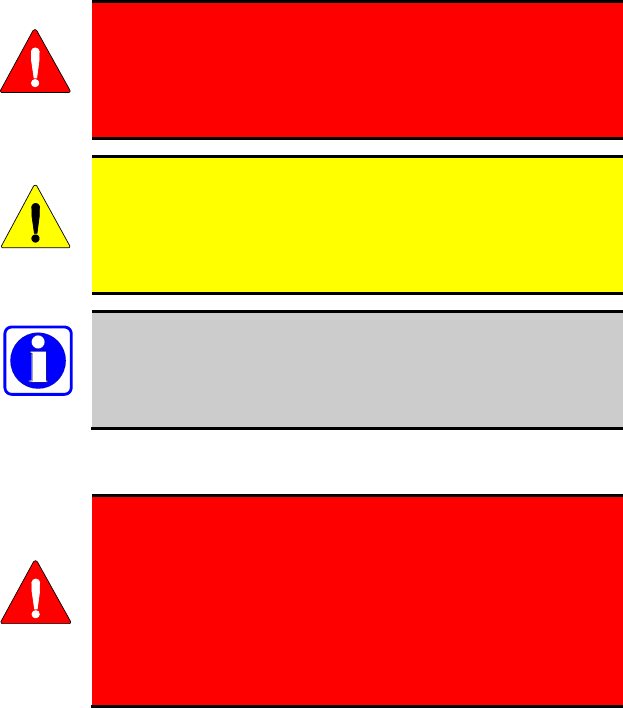
8 14221-1500-2010, Rev. E
1. REGULATORY AND SAFETY
INFORMATION
1.1 SAFETY SYMBOL CONVENTIONS
The following conventions are used to alert the user to general safety
precautions that must be observed during all phases of operation, service, and
repair of this product. Failure to comply with these precautions or with
specific warnings elsewhere violates safety standards of design, manufacture,
and intended use of the product. Harris assumes no liability for the customer's
failure to comply with these standards.
The WARNING symbol calls attention to a procedure,
practice, or the like, which, if not correctly performed or
adhered to, could result in personal injury. Do not proceed
beyond a WARNING symbol until the conditions identified
are fully understood or met.
The CAUTION
symbol calls attention to an operating
procedure, practice, or the like, which, if not performed
correctly or adhered to, could result in a risk of danger, damage
to the equipment, or severely degrade the equipment
performance.
The NOTE
symbol calls attention to supplemental
information, which may improve system performance or
clarify a process or procedure.
1.2 SAFETY TRAINING INFORMATION
The Harris XG-25P
portable radio generates RF
electromagnetic energy during transmit mode. This radio
is designed for and classified as “Occupational Use Only,”
meaning it must be used only during the course of
employment by individuals aware of the hazards and the
ways t
o minimize such hazards. This radio is NOT
intended for use by the “General Population” in an
uncontrolled environment.
The XG-25P portable radio has been tested and complies with the FCC RF
exposure limits for “Occupational Use Only.” In addition, this radio complies
with the following Standards and Guidelines with regard to RF energy and
WARNING
CAUTION
NOTE
WARNING

14221-1500-2010, Rev. E 9
electromagnetic energy levels and evaluation of such levels for exposure to
humans:
• FCC OET Bulletin 65 Edition 97-01 Supplement C, Evaluating
Compliance with FCC Guidelines for Human Exposure to Radio
Frequency Electromagnetic Fields.
• American National Standards Institute (C95.1 – 1992), IEEE Standard for
Safety Levels with Respect to Human Exposure to Radio Frequency
Electromagnetic Fields, 3 kHz to 300 GHz.
• American National Standards Institute (C95.3 – 1992), IEEE
Recommended Practice for the Measurement of Potentially Hazardous
Electromagnetic Fields – RF and Microwave.
• DIRECTIVE 2004/40/EC OF THE EUROPEAN PARLIAMENT AND
OF THE COUNCIL of 29 April 2004 on the minimum health and safety
requirements regarding the exposure of workers to the risks arising from
physical agents (electromagnetic fields) and amended by:
Directive 2007/30/EC of the European Parliament and of the Council
of 20 June 2007
Directive 2008/46/EC of the European Parliament and of the Council
of 23 April 2008
Regulation (EC) No 1137/2008 of the European Parliament and of
the Council of 22 October 2008
Directive 2012/11/EU of the European Parliament and of the Council
of 19 April 2012
1.2.1 RF Exposure Guidelines
To ensure that exposure to RF electromagnetic energy is within
the FCC
allowable limits for occupational use and/or the
exposure limit values in Annex A of EU Directive 2004/40/EC,
always adhere to the following guidelines:
• DO NOT operate the radio without a proper antenna attached, as this may
damage the radio and may also cause the FCC RF exposure limits and/or
the exposure limit values in Annex A of EU Directive 2004/40/EC to be
exceeded. A proper antenna is the antenna supplied with this radio by
Harris or an antenna specifically authorized by Harris for use with this
radio.
• DO NOT transmit for more than 50% of total radio use time (“50% duty
cycle”). Transmitting more than 50% of the time can cause FCC RF
exposure compliance requirements and/or the exposure limit values in
Annex A of EU Directive 2004/40/EC to be exceeded. The radio is
CAUTION
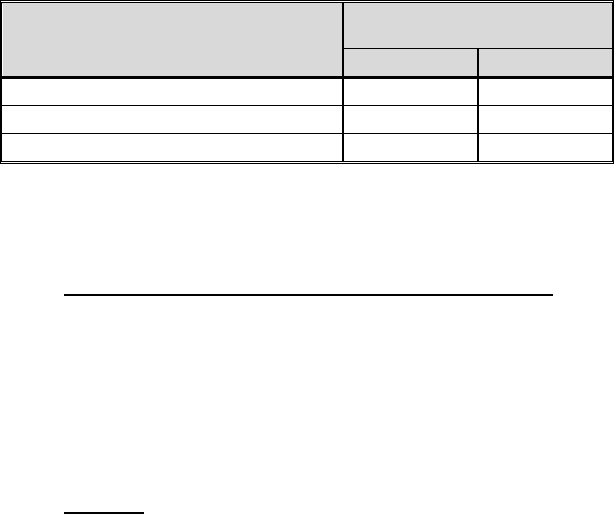
10 14221-1500-2010, Rev. E
transmitting when the “TX” indicator appears in the display. The radio
will transmit by pressing the “PTT” (Push-To-Talk) button.
• ALWAYS transmit using low power when possible. In addition to
conserving battery charge, low power can reduce RF exposure.
• ALWAYS use Harris authorized accessories (antennas, batteries, belt
clips, speaker/mics, etc). Use of unauthorized accessories may cause the
FCC Occupational/Controlled Exposure RF compliance requirements
and/or the exposure limit values in Annex A of EU Directive 2004/40/EC
to be exceeded. (Refer to Table 1-1.)
• As noted in Table 1-1, ALWAYS keep the housing of the transmitter AT
LEAST 1.5 cm (0.59 inches) from the body and at least 2.5 cm (1.0 inch)
from the face when transmitting to ensure FCC RF exposure compliance
requirements and/or the exposure limit values in Annex A of EU
Directive 2004/40/EC are not exceeded. However, to provide the best
sound quality to the recipients of your transmission, Harris recommends
you hold the microphone at least 5 cm (2 inches) from mouth, and slightly
off to one side.
Table 1-1: RF Exposure Compliance Tested Distances
RADIO FREQUENCY
BAND
TESTED DISTANCES
(worst case scenario)
Body Face
VHF (136-174 MHz) 1.5 cm 2.5 cm
700/800 MHz 1.6 cm 2.5 cm
UHF-L (378-470 MHz) 1.6 cm 2.5 cm
The information in this section provides the information needed to make the
user aware of a RF exposure, and what to do to assure that this radio operates
within the FCC RF exposure limits of this radio.
1.2.2 Electromagnetic Interference/Compatibility
During transmissions, Harris radios generate RF energy that can possibly
cause interference with other devices or systems. To avoid such interference,
turn off the radios in areas where signs are posted to do so. DO NOT operate
the transmitter in areas that are sensitive to electromagnetic radiation such as
hospitals, aircraft, and blasting sites.
1.3 REGULATORY APPROVALS
1.3.1 Part 15
This device complies with Part 15 of the FCC Rules. Operation is subject to
the following two conditions:
1. This device may not cause harmful interference, and
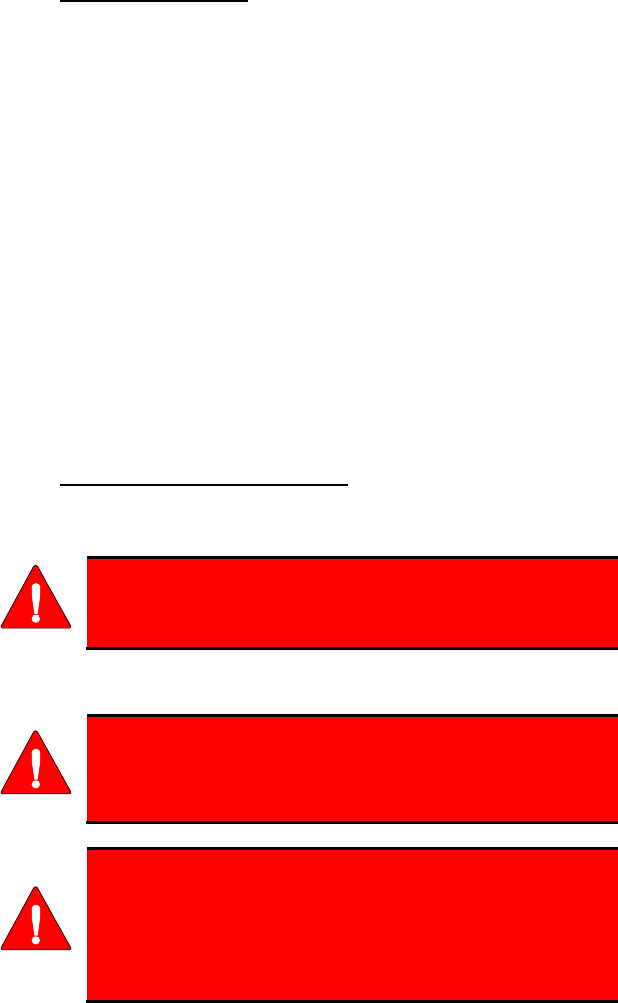
14221-1500-2010, Rev. E 11
2. This device must accept any interference received, including interference
that may cause undesired operation.
1.3.2 Industry Canada
This device complies with Industry Canada license-exempt RSS standard(s).
Operation is subject to the following two conditions: (1) this device may not
cause interference, and (2) this device must accept any interference, including
interference that may cause undesired operation of the device.
1.4 OPERATING TIPS
Antenna location and condition are important when operating a portable radio.
Operating the radio in low lying areas or terrain, under power lines or bridges,
inside of a vehicle or in a metal framed building can severely reduce the range
of the unit. Mountains can also reduce the range of the unit.
In areas where transmission or reception is poor, some improvement may be
obtained by ensuring the antenna is vertical. Moving a few yards in another
direction or moving to a higher elevation may also improve communications.
Vehicular operation can be aided with the use of an externally mounted
antenna.
Battery condition is another important factor in the trouble free operation of a
portable radio. Always properly charge the batteries.
1.4.1 Efficient Radio Operation
Keep the antenna in a vertical position when receiving or transmitting a
message.
Do NOT hold onto the antenna when the radio is powered
on.
1.4.1.1 Antenna Care and Replacement
Always keep the antenna at least 0.43 inches (1.5 cm) away
from the body and 1.0 inch (2.5 cm) from the face when
transmitting to ensure FCC RF exposure compliance
requirements are not exceeded.
Do not use the portable radio with a damaged or missing
antenna. A minor burn may result if skin comes into
contact with a
damaged antenna. Replace a damaged
antenna immediately. Operating a portable radio with the
antenna missing could cause personal injury, damage the
radio, and may violate FCC regulations.
WARNING
WARNING
WARNING
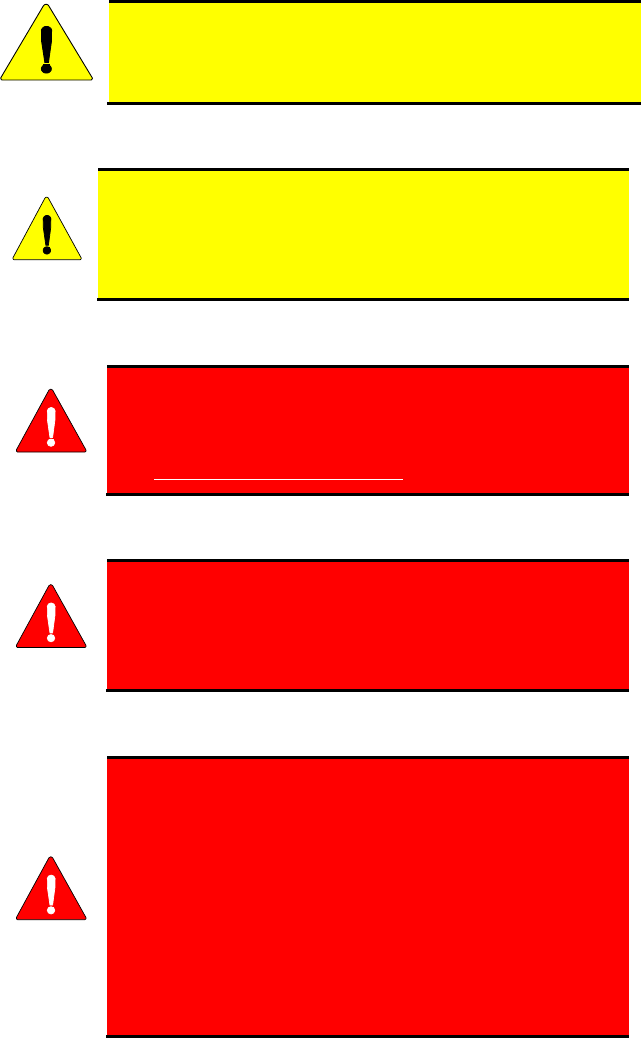
12 14221-1500-2010, Rev. E
Use only the supplied or approved antenna. Unauthorized
antennas, modifications, or attachments could cause damage to
the radio unit and may violate FCC regulations.
1.4.1.2 Electronic Devices
RF energy from portable radios may affect some electronic
equipment. Most modern electronic equipment in cars,
hospitals, homes, etc., are shielded from RF energy. However,
in areas in which you are instructed to turn off two-way radio
equipment, always observe the rules. If in doubt, turn it off!
1.4.1.3 Aircraft
Always turn off a portable radio before boarding any
aircraft!
• Use it on the ground only with crew permission.
• DO NOT use while in-flight!!
1.4.1.4 Electric Blasting Caps
To prevent accidental detonation of electric blasting caps,
DO NOT use two-way radios within 1000 feet of blasting
operations. Always obey the "Turn Off Two-Way Radios"
signs posted where electric blasting caps are being used.
(OSHA Standard: 1926.900)
1.4.1.5 Potentially Explosive Atmospheres
Areas with potentially explosive atmospheres are often,
but not always, clearly marked. These may be fuelling
areas, such as gas stations, fuel or chemical transfer or
storage facilities, and areas where the air contains
chemicals or particles, such as grain, dust, or metal
powders.
Sparks in such areas could cause an explosion or fire
resulting in bodily injury or even death.
Turn OFF two-
way radios when in any area with a
potentially explosive atmosphere. It is rare, but not
impossible that a radio or its accessories could generate
sparks.
CAUTION
CAUTION
WARNING
WARNING
WARNING
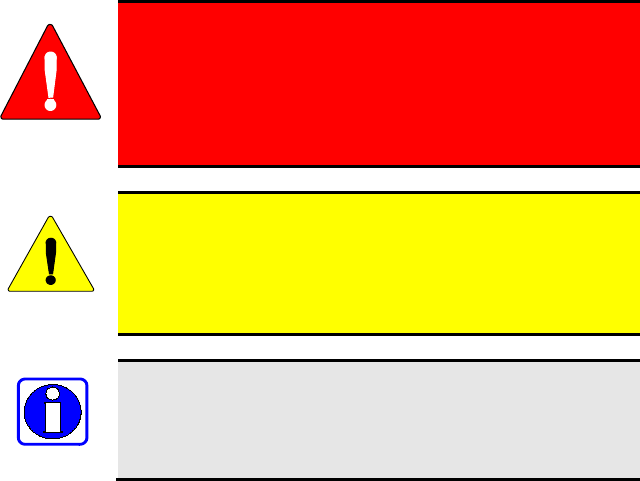
14221-1500-2010, Rev. E 13
2. RENSEIGNEMENTS SUR LA
RÉGLEMENTATION ET SÉCURITÉ
2.1 CONVENTIONS SUR LES SYMBOLES DE
SÉCURITÉ
Les conventions suivantes sont utilisées dans le présent manuel pour avertir
l’utilisateur des précautions générales de sécurité qui doivent être observées
pendant toutes les phases d’opération, d’entretien et de réparation de ce
produit. Le non-respect de ces précautions ou d’avertissements précisés
ailleurs enfreint les normes de sécurité de la conception, de la fabrication et de
l’utilisation prévue du produit. Harris n’assume aucune responsabilité pour le
non-respect de ces normes par le client.
MISE EN GARDE
Le symbole MISE EN GARDE attire l’attention sur une
procédure ou une pratique qui, si elle n’est pas
correctement effectuée ou observée, pourrait entraîner
une blessure personnelle. Ne pas poursuivre au-delà d’un
symbole de MISE EN GARDE avant que les conditions
identifiées soient complètement comprises ou satisfaites.
AVERTISSEMENT
Le symbole AVERTISSEMENT
attire l’attention sur une
procédure ou une pratique opérationnelle qui, si elle n’est pas
correctement effectuée ou observée, pourrait entraîner un bris
d’équipement ou une importante baisse de rendement de
l’équipement.
REMARQUE
Le symbole REMARQUE
attire l’attention sur des
renseignements supplémentaires qui peuvent améliorer le
rendement du système ou clarifier un processus ou une
procédure.
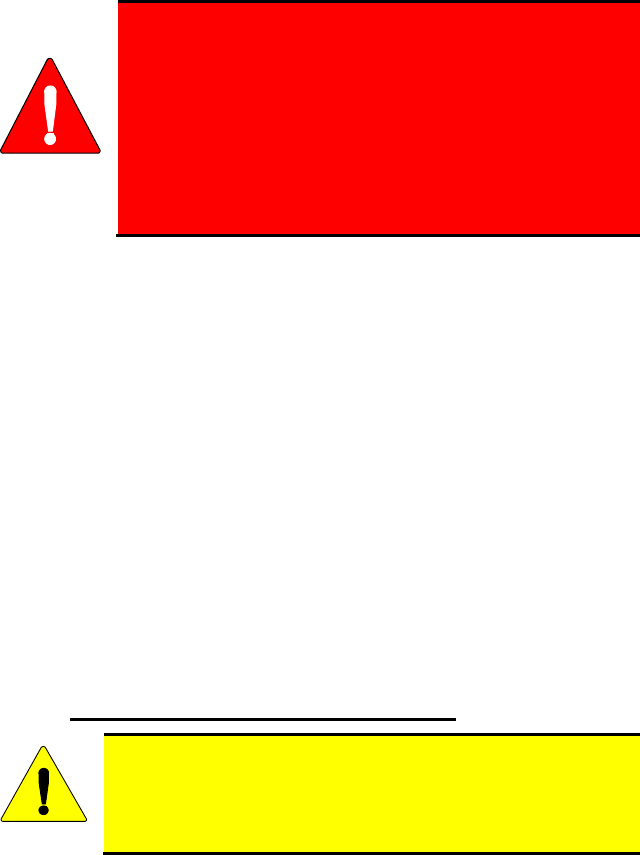
14 14221-1500-2010, Rev. E
2.2 RENSEIGNEMENTS SUR LA FORMATION SUR
LA SÉCURITÉ
MISE EN GARDE
La radio portative Harris XG-25P produit de l’énergie
électromagnétique des RF lorsqu’
en mode de
transmission. Cette radio est conçue et classée pour une
« Utilisation professionnelle seulement
», ce qui signifie
qu’elle ne doit être utilisée que dans le cadre d’un emploi
par des individus conscients des risques et des moyens de
limiter ceux-ci. Cette radio N’EST PAS conçue pour une
utilisation par la « Population générale
» dans un
environnement non contrôlé.
La radio portative XG-25P a été testée et est conforme aux limites
d’exposition aux RF de la FCC pour une « Utilisation professionnelle
seulement ». De plus, cette radio Harris est conforme aux normes et directives
suivantes quant à l’énergie des RF et aux niveaux d’énergie
électromagnétique, ainsi qu’à l’évaluation de ces niveaux pour l’exposition
aux humains :
• Bulletin 65 du OET de la FCC, édition 97-01, supplément C, portant sur
l’évaluation de la conformité aux directives de la FCC quant à
l’exposition humaine aux champs électromagnétiques des
radiofréquences.
• American National Standards Institute (C95.1 – 1992), norme de l’IEEE
sur les niveaux sécuritaires d’exposition humaine aux champs
électromagnétiques des radiofréquences, 3 kHz à 300 GHz.
• American National Standards Institute (C95.3 – 1992), pratique
recommandée par l’IEEE pour la mesure des champs électromagnétiques
potentiellement dangereux – RF et micro-ondes.
2.2.1 Directives sur l’exposition aux RF
AVERTISSEMENT
Pour s’assurer que l’exposition à l’énergie électromagnétique
des RF se situe dans les limites acceptables de la FCC pour
l’
utilisation professionnelle, respectez toujours les directives
suivantes :
• N’utilisez PAS la radio sans qu’une antenne appropriée y soit connectée,
car ceci peut endommager la radio et également causer un dépassement
des limites d’exposition aux RF de la FCC. Une antenne appropriée est
celle fournie par Harris avec cette radio, ou une antenne spécifiquement
autorisée par Harris pour être utilisée avec cette radio.

14221-1500-2010, Rev. E 15
• Ne transmettez PAS pendant plus de 50 % de la durée d’utilisation totale
de la radio (« cycle de service de 50 % »). La transmission pendant plus
de 50 % du temps peut causer un dépassement des exigences de
conformité de la FCC en matière d’exposition aux RF. La radio transmet
lorsque l’indicateur « TX » apparaît sur l’affichage. La radio transmet
lorsqu’on appuie sur le bouton « PTT » (bouton de microphone).
• Transmettez TOUJOURS en basse puissance lorsque possible. En plus de
préserver la charge de la pile, une faible puissance réduit l’exposition aux
RF.
• Utilisez TOUJOURS des accessoires autorisés Harris (antennes, piles,
pinces de ceinture, haut-parleurs/micros, etc.). L’utilisation d’accessoires
non autorisés peut entraîner un dépassement des exigences de conformité
pour une exposition aux RF professionnelle ou contrôlée de la FCC.
(Reportez-vous à Tableau 2-1.)
• Tel qu’indiqué dans Tableau 2-1, conservez TOUJOURS l’appareil et son
antenne à AU MOINS 1,5 cm (0,59 po) du corps, et à au moins 2,5 cm
(1,0 po) du visage pendant la transmission, pour vous assurer de ne pas
dépasser les exigences de conformité de la FCC en matière d’exposition
aux RF. Cependant, pour offrir la meilleure qualité sonore aux auditeurs
de votre transmission, Harris recommande de tenir le microphone à au
moins 5 cm (2 po) de votre bouche et légèrement déplacé sur un côté.
Tableau 2-1 : Distances de test de conformité des expositions aux RF
RADIOFRÉQUENCES
DISTANCES TESTÉES
(pire des scénarios)
Corps Visage
VHF (136-174 MHz) 1,5 cm 2,5 cm
700/800 MHz 1,6 cm 2,5 cm
UHF-L (378-470 MHz) 1,6 cm 2,5 cm
Dans cette section figurent les renseignements nécessaires pour sensibiliser
l’utilisateur à l’exposition aux RF et sur ce qu’il faut faire pour s’assurer que
cette radio fonctionne dans les limites d’exposition aux RF de la FCC.
2.2.2 Interférence/Compatibilité Électromagnétique
Pendant les transmissions, cette radio Harris produit de l’énergie des RF qui
peut causer de l’interférence avec d’autres appareils ou systèmes. Pour éviter
de telles interférences, fermez la radio dans les zones où il est indiqué de le
faire. N’utilisez PAS le transmetteur dans des zones sensibles aux radiations
électromagnétiques, comme les hôpitaux, les avions et les sites de détonation.

16 14221-1500-2010, Rev. E
2.3 INTERFÉRENCE DES RADIOFRÉQUENCES
2.3.1 Partie 15 de la FCC
Cet appareil est conforme à la Partie 15 de la réglementation de la FCC. Le
fonctionnement est soumis aux deux conditions suivantes :
1. Cet appareil ne doit pas causer une interférence nuisible; et
2. Cet appareil doit accepter toute interférence reçue, y compris une
interférence qui peut causer un fonctionnement non souhaité.
2.3.2 Industrie Canada
Cet appareil est conforme aux normes RSS exemptées de licence d’Industrie
Canada. Le fonctionnement est soumis aux deux conditions suivantes : (1) cet
appareil ne doit pas causer d’interférence et (2) cet appareil doit accepter toute
interférence, y compris une interférence qui peut causer un fonctionnement
non souhaité de l’appareil.
2.4 CONSEILS D’UTILISATION
L’emplacement et l’état de l’antenne sont importants pour l’utilisation d’une
radio portative. L’utilisation de la radio dans des zones de faible élévation,
sous des lignes électriques ou des ponts, à l’intérieur d’un véhicule ou dans un
immeuble à ossature métallique, peut réduire la portée de l’appareil de
manière considérable. Les montagnes peuvent également réduire la portée de
l’unité.
Dans les zones où la transmission ou la réception est insatisfaisante, certaines
améliorations peuvent être obtenues en s’assurant que l’antenne est verticale.
Se déplacer de quelques mètres dans une autre direction ou à un emplacement
plus élevé peut également améliorer les communications. L’utilisation d’une
antenne fixée à l’extérieur peut faciliter le fonctionnement dans un véhicule.
L’état de la pile est un autre facteur important d’une utilisation sans tracas
d’une radio portative. Chargez toujours correctement la pile.
2.4.1 Utilisation Efficace de la Radio
Gardez l’antenne dans une position verticale pendant la réception ou la
transmission d’un message.
MISE EN GARDE
Ne tenez PAS l’antenne lorsque la radio est allumée!
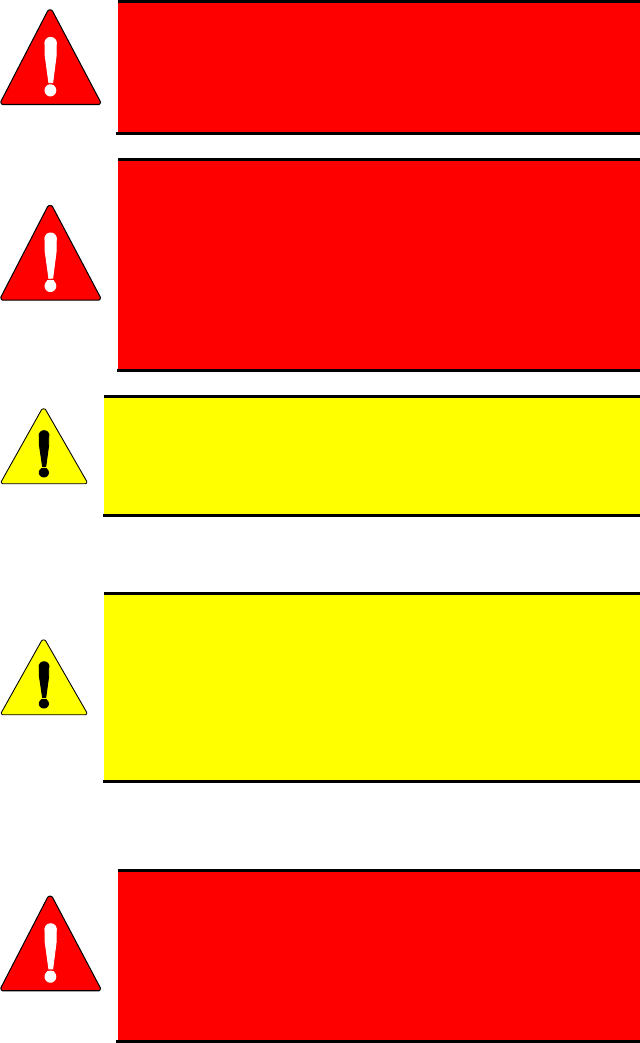
14221-1500-2010, Rev. E 17
2.4.1.1 Entretien et Remplacement de l’antenne
MISE EN GARDE
Conservez TOUJOURS l’appareil et son antenne à au
moins 1,5 cm (0,59 po) du corps, et à au moins 2,5 cm
(1,0
po) du visage pendant la transmission, pour vous
assurer de ne pas dépasser les exigences de conformité de
la FCC en matière d’exposition aux RF.
MISE EN GARDE
N’
utilisez pas la radio portative si son antenne est
endommagée ou absente. Une brûlure légère peut se
produire au contact d’une antenne endommagée avec la
peau. Remplacez immédiatement une antenne
endommagée. L’utilisation d’une radio portative alors que
l’
antenne est absente peut causer des blessures,
endommager la radio et pourrait enfreindre la
réglementation de la FCC.
AVERTISSEMENT
Utilisez seulement l’antenne fournie ou une antenne approuvée.
Des antennes non autorisées, des modifications ou des ajouts à
une antenne peuvent endommager la radio et enfreindre la
réglementation de la FCC.
2.4.1.2 Appareils Électroniques
AVERTISSEMENT
L’énergie des RF provenant de radios portatives peut affecter
certains appareils électroniques. La majorité de l’équipement
électronique moderne dans les voitures, les hôpitaux, les
maisons, etc. est blindé contre l’énergie des RF. Cependant,
dans les zones où l’on vous demande de fermer l’équipement de
radio bidirectionnelle, respectez toujours les règles. En cas de
doute, éteignez-le!
2.4.1.3 Avion
MISE EN GARDE
•
Éteignez toujours une radio portative avant
d’embarquer à bord d’un avion!
• Ne l’utilisez au sol qu’
avec la permission de
l’équipage.
• NE l’utilisez PAS durant le vol!
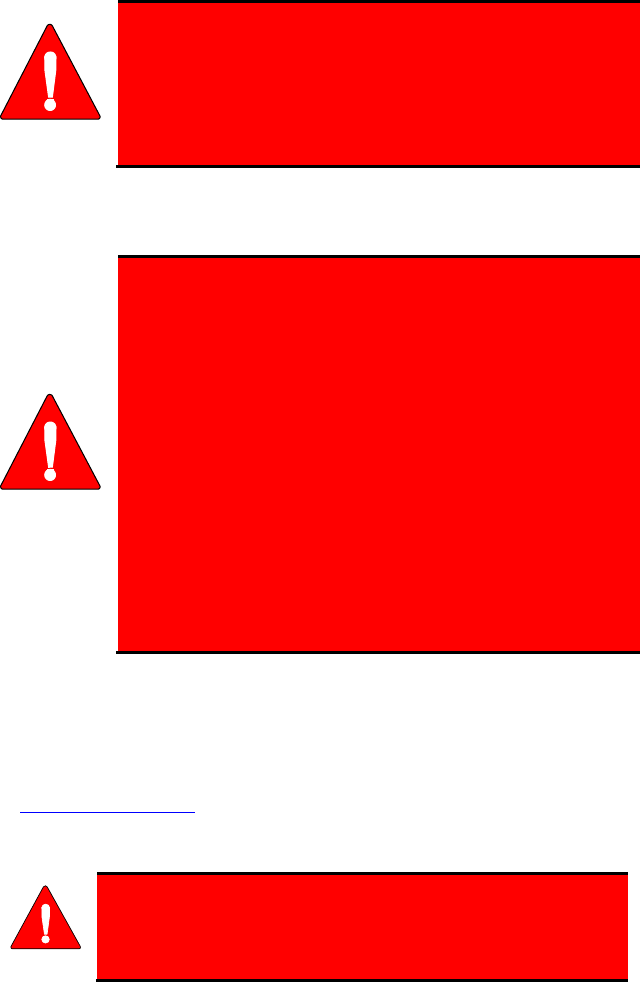
18 14221-1500-2010, Rev. E
2.4.1.4 Détonateurs électriques
MISE EN GARDE
Pour prévenir la détonation accidentelle des détonateurs
électriques, n’
utilisez PAS de radios bidirectionnelles à
moins de 305 m (1 000 pi) des opérations de détonation.
Respectez toujours les indications «
Éteindre les radios
bidirectionnelles
» situées là où des détonateurs
électriques sont utilisés. (Norme OSHA : 1926.900)
2.4.1.5 Atmosphère Potentiellement Explosive
MISE EN GARDE
Les zones ayant une atmosphère potentiellement explosive
sont souvent, mais pas toujours, identifiées clairement
comme telles. Il peut s’agir de zones d’
alimentation en
carburant, comme les postes d’essence, les installations de
stockage ou de transfert de carburant ou de produits
chimiques, ainsi que les zones dont l’
air contient des
produits chimiques ou des particules, comme des grains,
de la poussière ou des poudres métalliques.
Des étincelles dans de telles zones peuvent provoquer une
explosion ou un incendie, causant ainsi des blessures ou
même la mort.
Éteignez les radios bidirectionnelles dans toute zone ayant
une atmosphère potentiellement explosive. Il est rare, mais
pas impossible qu’une radio ou ses accessoires produisent
des étincelles.
3. OPTIONS AND ACCESSORIES
A complete list of Options and Accessories approved for use with the XG-25P
portable radio can be found online in the Operator’s Manual 14221-1500-2000
at www.pspc.harris.com. Also reference the maintenance manual or Harris’
Products and Services Catalog for all available options and accessories,
including those items that do not adversely affect the RF energy exposure.
Always
use Harris authorized accessories (antennas,
batteries, belt clips, speaker/mics, etc). Use of unauthorized
accessories may cause the FCC Occupational/Controlled
Exposure RF compliance requirements to be exceeded.
WARNING
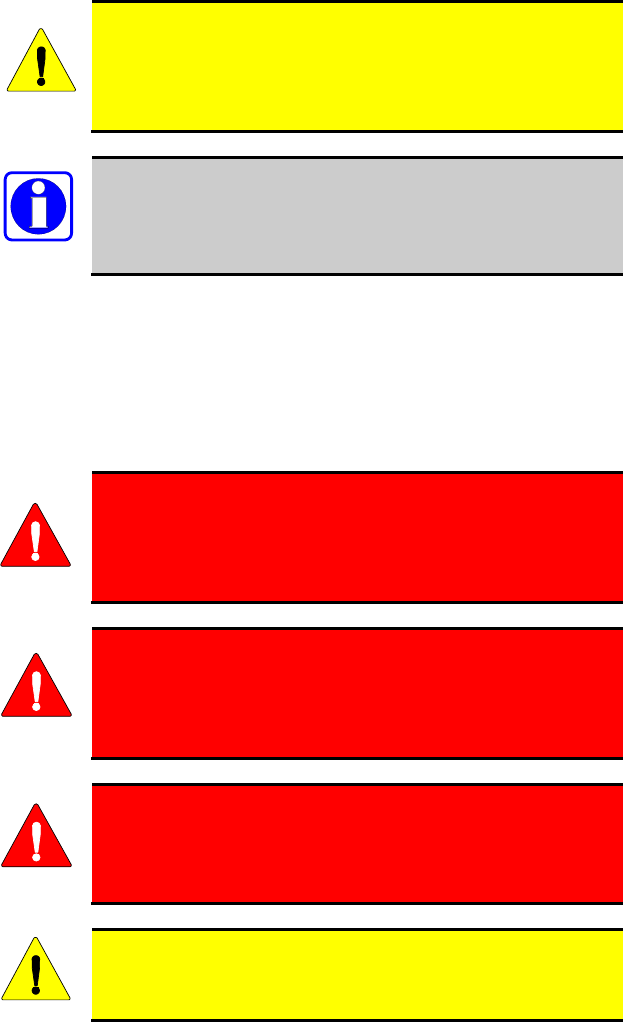
14221-1500-2010, Rev. E 19
Always
use the correct options and accessories (battery,
antenna, speaker/mic, etc.) for the radio. Immersion rated
options must be used with an immersion rated radio.
Hazardous Location (HAZLOC) Certified
options must be
used with HAZLOC Certified radios.
Refer to p
roduct label or HAZLOC Certification for Class,
Division, and Temperature Rating.
4. BATTERY PACKS
The XG-25P series portable radios use rechargeable, recyclable Nickel Metal
Hydride (NiMH), Lithium-Polymer (Li-Poly), or Lithium Ion (Li-Ion) battery
packs. Please follow the directions below to maximize the useful life of each
type of battery pack.
Do not disassemble or modify Lithium battery packs. The
Lithium battery packs are equipped with built-
in safety
and protection features. Should these features be disabled
or tampered with in any way, the battery pack can leak
electrolyte, overheat, emit smoke, burst, and/or ignite.
If the battery pack is ruptured or is leaking electrolyte
that results in skin or eye contact with the electrolyte,
immediately flush the affected area with water. If the
battery electrolyte gets in the eyes, flush with water for 15
minutes and consult a physician immediately.
DO NOT remove, install, or charge batteries in potentially
explosive atmosphere areas.
Sparks in such areas could cause an explosion or fire
resulting in bodily injury or even death.
Always use Harris authorized chargers and conditioners. Use
of unauthorized chargers and conditioners may void the
warranty.
CAUTION
NOTE
WARNING
WARNING
WARNING
CAUTION
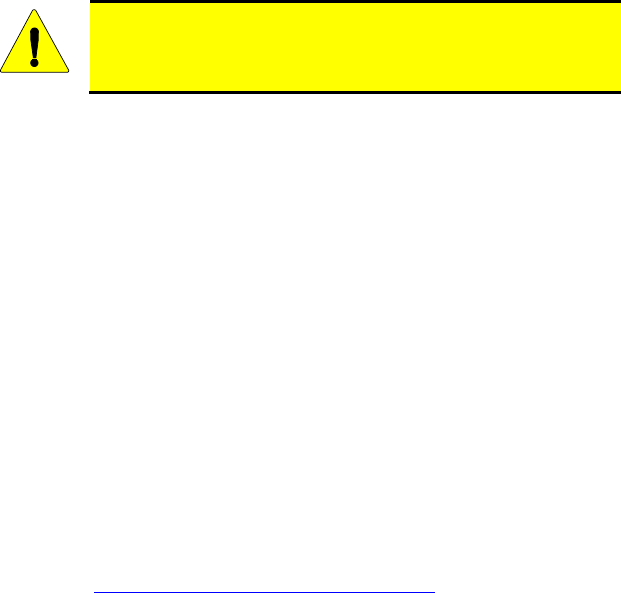
20 14221-1500-2010, Rev. E
4.1 CONDITIONING NIMH BATTERY PACKS
Condition a new NiMH battery pack before putting into use. This also applies
to rechargeable NiMH battery packs that have been stored for long periods
(weeks, months, or longer). Conditioning requires fully charging and fully
discharging the battery pack three (3) times using the tri-chemistry charger.
The first time the battery pack is put into the charger, this unit will condition
Nickel-based battery packs by automatically charging and discharging
(cycling) the battery. Refer to the appropriate charger manual for details.
Failure to properly condition NiMH battery packs before initial
use will result in shortened performance by the battery.
4.2 CONDITIONING LITHIUM BATTERY PACKS
Lithium-based battery packs do not suffer from memory effect and therefore
do not require conditioning.
4.3 STORING LI-ION BATTERY PACKS
If a battery pack is expected to be idle for a month or more, it should be
properly prepared. Li-Ion battery packs should not be stored fully charged.
Before storing the battery pack, discharge it to 40% capacity. If the battery is
not discharged prior to storage, its overall capacity may be reduced. Although
all battery packs experience some capacity loss during storage, the shelf life
for Li-Ion battery packs is about 3 months. However, note that any capacity
drop which occurs during storage is permanent and cannot be reversed. Li-Ion
battery packs should be purchased and used immediately. They should not be
stock-piled without a rotating stock plan.
4.4 ADDITIONAL INFORMATION
For more information regarding the proper care of portable radio battery packs
or establishing a battery maintenance program, refer to ECR-7367 which may
be ordered by calling toll free 1-800-368-3277 (international - 1-434-455-
6403) or via https://premier.pspc.harris.com/infocenter/.
CAUTION
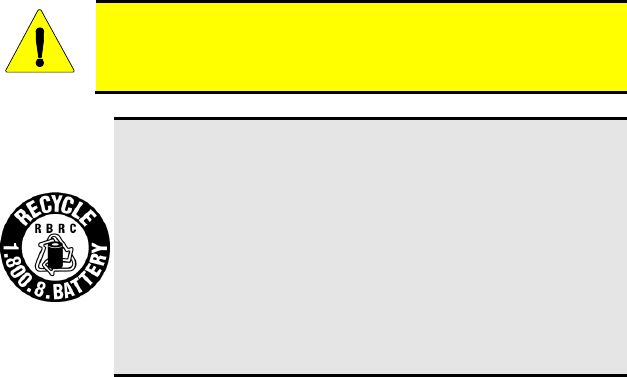
14221-1500-2010, Rev. E 21
4.5 BATTERY DISPOSAL
In no instance should a battery pack be incinerated. Disposing
of a battery pack by burning will cause an explosion.
RECHARGEABLE BATTERY PACK DISPOSAL – The
product you have purchased contains a rechargeable battery
pack. The battery pack is recyclable. At the end of its useful
life, under various state and local laws, it may be illegal to
dispose of this battery pack
into the municipal waste stream.
Check with your local solid waste officials for details in your
area for recycling options or proper disposal. Canadian and
U.S. users may call Toll Free 1-800-8-BATTERY® for
information and/or procedures for returning rechargeable
batteries in your locality.
CAUTION

22 14221-1500-2010, Rev. E
5. TECHNICAL ASSISTANCE
The Technical Assistance Center's (TAC’s) resources are available to help
with overall system operation, maintenance, upgrades and product support.
TAC is your point of contact when answers are needed to technical questions.
Product specialists, with detailed knowledge of product operation,
maintenance, and repair, provide technical support via a toll-free (in North
America) telephone number. Support is also available through mail, fax and
e-mail.
For more information about technical assistance services, contact your sales
representative, or call the Technical Assistance Center directly at:
North America: 1-800-528-7711
International: 1-434-385-2400
Fax: 1-434-455-6712
E-mail: PSPC_tac@harris.com
6. WARRANTY
Please register this product within 10 days of purchase. Registration validates
the warranty coverage, and enables Harris to contact you in case of any safety
notifications issued for this product.
Registration can be made on-line at the Customer Care center webpage:
http://www.pspc.harris.com/Service/Customerservice.aspx.
While on the webpage, please review the applicable battery and/or product
warranty literature.
14221-1500-2010, Rev. E 23
NOTES

About Harris Corporation
Harris Corporation is a leading technology
innovator that creates mission-critical solutions
that connect, inform and protect the world.
The company’s advanced technology provides
information and insight to customers operating
in demanding environments from ocean to
orbit and everywhere in between. Harris has
approximately $8 billion in annual revenue and
supports customers in 125 countries through
four customer-
focused business segments:
Communication System
s, Space and
Intelligence Systems, Electronic Systems, and
Critical Networks.
FLORIDA NEW YORK VIRGINIA BRAZIL UNITED KINGDOM UAE SINGAPORE